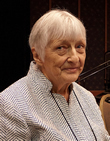 A heavyweight in the field of seismology who drove research efforts in the former Soviet Union, Tanya Glebovna Rautian, often called “The Charles Richter of the former Soviet Union” and “generator of ideas,” has dedicated her life to the development of seismology and science in central Asia. She is widely recognized as a pioneer in the study of earthquake source, in the quantification of the seismic coda and in the discrimination of nuclear explosions from earthquakes. Rautian studied physics at the University of Leningrad in the late 1940s and early 1950s. She turned her attention to seismology in 1951 when she and her husband, Vitaly I. Khalturin, left the urban research centers of Moscow and Leningrad behind to establish a seismograph station near Garm in the mountains of Tajikistan. Establishing the research station wasn’t easy. In those days, roads were nearly impassable, electricity was only produced by private generators and modern plumbing had yet to appear. Over the 35 years they spent there, Rautian and Khalturin raised five daughters, helped build a seismological observatory that was the world center of earthquake prediction research in the 1960s and 1970s, and worked to train an entire generation of seismologists studying the seismically active areas of Soviet Central Asia. Isolated from modern technology and seismological literature published in the west, Rautian presented her “energy scale,” which estimated the energy radiated by an earthquake, and in contrast to the Richter scale, sought to link magnitude value directly to the energy radiated by the earthquake. The theoretical work was accompanied by the development of a practical set of nomograms used by Soviet scientists for earthquake location and energy determination. Soviet scientists through much of the latter half of the 20th century relied on “Rautian’s energy scale” to quantify the size of an earthquake. Living for four decades surrounded by the Pamir and Tien Shan mountains, Rautian was treated to a dizzying array of seismic sources that surrounded the research facility where she worked in Garm. Her work involved painstaking analysis of thousands of seismograms. She determined magnitudes, measured spectra, determined attenuation factors and analyzed source characteristics for the thousands of earthquakes recorded by Garm’s network of seismographs each year. Most of her work was published in Russian-language monographs that were largely inaccessible to scientists outside the Soviet Union. Rautian’s second area of contribution to seismology relates to using coda waves to study the seismic source and the attenuation of seismic waves. Her work was parallel to that carried out by Kei Aki and others in the U.S. during the same time period and brought important new observational insights to the topic.
A heavyweight in the field of seismology who drove research efforts in the former Soviet Union, Tanya Glebovna Rautian, often called “The Charles Richter of the former Soviet Union” and “generator of ideas,” has dedicated her life to the development of seismology and science in central Asia. She is widely recognized as a pioneer in the study of earthquake source, in the quantification of the seismic coda and in the discrimination of nuclear explosions from earthquakes. Rautian studied physics at the University of Leningrad in the late 1940s and early 1950s. She turned her attention to seismology in 1951 when she and her husband, Vitaly I. Khalturin, left the urban research centers of Moscow and Leningrad behind to establish a seismograph station near Garm in the mountains of Tajikistan. Establishing the research station wasn’t easy. In those days, roads were nearly impassable, electricity was only produced by private generators and modern plumbing had yet to appear. Over the 35 years they spent there, Rautian and Khalturin raised five daughters, helped build a seismological observatory that was the world center of earthquake prediction research in the 1960s and 1970s, and worked to train an entire generation of seismologists studying the seismically active areas of Soviet Central Asia. Isolated from modern technology and seismological literature published in the west, Rautian presented her “energy scale,” which estimated the energy radiated by an earthquake, and in contrast to the Richter scale, sought to link magnitude value directly to the energy radiated by the earthquake. The theoretical work was accompanied by the development of a practical set of nomograms used by Soviet scientists for earthquake location and energy determination. Soviet scientists through much of the latter half of the 20th century relied on “Rautian’s energy scale” to quantify the size of an earthquake. Living for four decades surrounded by the Pamir and Tien Shan mountains, Rautian was treated to a dizzying array of seismic sources that surrounded the research facility where she worked in Garm. Her work involved painstaking analysis of thousands of seismograms. She determined magnitudes, measured spectra, determined attenuation factors and analyzed source characteristics for the thousands of earthquakes recorded by Garm’s network of seismographs each year. Most of her work was published in Russian-language monographs that were largely inaccessible to scientists outside the Soviet Union. Rautian’s second area of contribution to seismology relates to using coda waves to study the seismic source and the attenuation of seismic waves. Her work was parallel to that carried out by Kei Aki and others in the U.S. during the same time period and brought important new observational insights to the topic.
Rautian was also active in facilitating exchanges in the 1970s between American and Soviet scientists. She and her husband moved to the U.S. in 1993, spending extended research terms at Indiana University and the Lamont –Doherty Earth Observatory, where they continued work on seismic coda and developed new research devoted to distinguishing nuclear explosions from earthquakes. They also interacted with dozens of scholars, students and collaborators from other institutions, providing a fresh perspective for many American seismology students.
